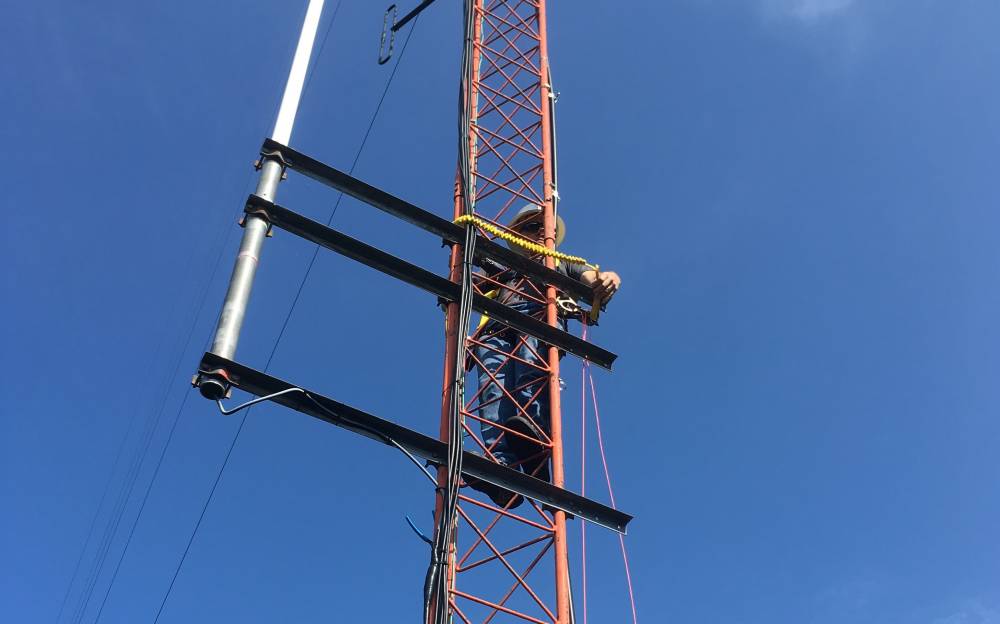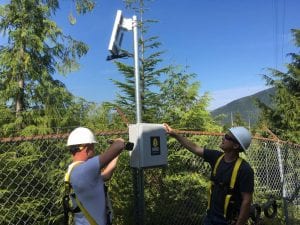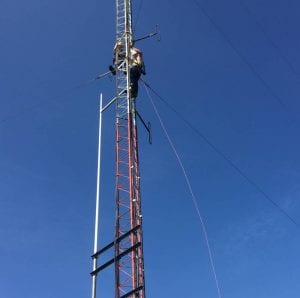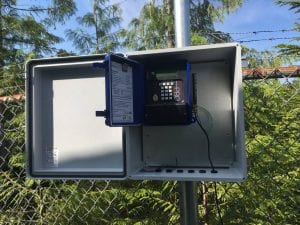
Despite some recent rainy weather, the ongoing drought in Southeast Alaska has led to decreased availability of hydroelectric power, more reliance on diesel, and many conversations about alternative sources of energy.
To that end, Southeast Alaska Power Agency is collecting data to find out whether wind-generated energy would work for the region. And it turns out the best place in Ketchikan to install wind-data equipment is on the KRBD radio tower.

Clay Hammer and Robert Seidman install a weatherproof box on the inside of a fence surrounding KRBD’s transmission tower. The equipment inside the box connects to two anemometers – little whirligigs that measure wind speed — plus a wind vane to record direction.
“We do have another module for temperature and atmospheric pressure and all that kind of good stuff,” Hammer said. “But we need to get in there and actually verify that there’s any wind at all.”
Hammer is SEAPA’s operations manager, and works out of Wrangell. He said projects like these are interesting, plus it’s good community service.
“The results could possibly have a real good positive outcome for the community if this does prove to be a viable source of wind generation for the future, it would definitely be a boon for the community,” he said. “And it’s just kind of exciting. Everybody has got a little bit of kid in them, right? And likes to go climb trees and towers? It’s kind of fun, too.”
It’s a perfect day to install the equipment: sunny with a light breeze – at least on the ground.
Once they finish installing the collection box, Hammer and Seidman start climbing the tower. They have full safety gear, and take their time. Hammer went first.
“If this was back in my high school days, I would just be scampering right up this darned thing and throw caution to the wind,” he said, as he as he maneuvered his harness around an obstacle on the tower.

Once he got up above the tree line, Hammer reported a much stronger wind than we felt on the ground.
“No doubt about it, the wind does blow up here,” he called down.
They place the equipment about halfway up the tower, separating the two anemometers by about 20 feet to get data from different elevations.
There have been previous studies in Southeast on wind energy potential, conducted by the state. But Hammer said that was all computer modeling. This new data will be more reliable.
Once they’re back on the ground, Seidman hooks up the long cables to the data collection box, and checks to see whether it’s all working. A computer readout shows wind data coming in already.
“Five meters per second, that’s a constant speed,” he said, reading off the screen. “We want to see something more around eight meters per second, typically, for wind energy.”
Even though that day wasn’t blowing at the ideal speed, it’s not bad for a calm day. And, Seidman said they’re looking for an average speed. Some days will have more wind — a lot more.

The whole setup doesn’t use much power, so it has a solar panel that feeds a battery. It can last up to three months without any sunlight. It also has a cell-phone connection, so SEAPA can check the data remotely.
Trey Acteson is CEO of SEAPA. He said the study in Ketchikan will supplement other wind-data collection efforts outside of Wrangell.
“We will be looking at additional places to put sites, as well, as time goes,” he said. “Wind sighting is very challenging. It needs to be pretty close to our transmission to make it economical.”
And it’s potentially expensive to build – at least for the first wind turbine. The best place is on top of a mountain, and they’d need a road.
“But it’s part of our multi-pronged approach to look at the different energy-potential assets here,” Acteson said.
He said SEAPA is always looking at alternative energy sources. Some have more potential than others. The technology for tidal energy, for example, is still developing. Geothermal on Bell Island has been explored, but Acteson said that turned out to be cost-prohibitive.
Solar has improved in recent years, but even with much more efficient solar collection technology, we are still in Alaska.
“If you looked at the solar profile for all of the U.S., we have one of the worst locations in the entire U.S. for solar,” he said.
Acteson said not only do we not get quite enough light, solar requires a lot of space for all the panels. They haven’t ruled it out, though. It’s still on the list.
At this point, he said, wind has the most potential as a back-up source of energy when hydroelectricity isn’t available. This study will show whether that potential is realistic. But it won’t be quick.
Acteson said three to five years’ worth of data is ideal. But there is time, especially after it starts raining again at normal levels. While there’s currently a drought and lakes are low, Acteson said when SEAPA’s two lakes are producing hydroelectricity, local demand for power is pretty much met.
He said new sources should be developed in a way that doesn’t end up costing ratepayers more for something that isn’t really needed. But, they also need to know what’s possible for the future. The anemometers now whirling away on KRBD’s transmission tower are the first step.
KRBD is not receiving payment for SEAPA’s use of the transmission tower. This is a cooperative project to provide valuable information for the community.





